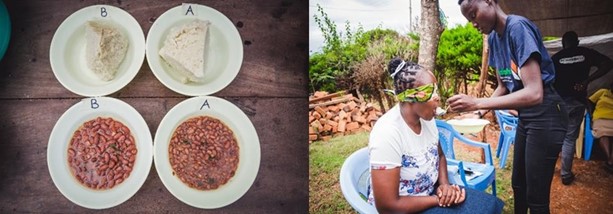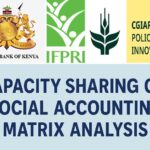December 5, 2024, 11:30am -2:30pm (Africa/Nairobi)
By Berber Kramer and Emily Kilonzi
The successful adoption of agricultural technologies, including drought-tolerant varieties, innovative insurance products, and efficient farming practices, is critical to ensuring food security. However, for technologies to be successfully integrated into farmers’ practices, there is a need to consider not only their performance but also how they are introduced, marketed, and supported throughout the adoption process. This is especially crucial for smallholder farmers, who face resource costraints and may be risk-averse when confronted with new agricultural innovations. The integration of such technologies, therefore, hinges on understanding the social, economic, and institutional dynamics that affect farmers’ willingness to invest in new technologies.
Since 2019, IFPRI has been partnering with the Africa Climate Risk Enterprise (ACRE) Africa Ltd. and the Kenya Agricultural and Livestock Research Organization (KALRO) on research to develop, implement and evaluate innovative agricultural insurance products to de-risk adoption of agricultural technologies, and new strategies to promote new varieties of maize, beans, and other important crops in Kenya’s food system. On December 5th, the research consortium convened to share the most recent findings from this research project with representatives from the study regions and other stakeholders in the country such as representatives from collaborating seed companies. The aim was to validate current research findings, identify gaps for future research, and explore the next steps in promoting new agricultural technologies.
Research overview: Key findings shared during the meeting
- Bundling with insurance to accelerate technology adoption
A first study analyzed the effects of insurance on the adoption of drought tolerant varieties (DTVs). Given that seeds of these varieties tend to cost more than seeds of conventional varieties, offering insurance alongside the seeds can help mitigate the financial risk associated with planting them. Two experiments across seven counties in Kenya find that:
- bundling seeds with insurance increases willingness to pay for seeds; but only if those seeds are not marketed as drought-tolerant varieties, suggesting that farmers perceive drought tolerance and insurance to be substitutes for one another.
- farmers are willing to pay more for insurance when it also invests in pesticides,
indicating a preference for comprehensive coverage, and that unlike DTVs, they perceive pesticides as complementary rather than substitutes for insurance;
- providing insurance increases technology adoption, but especially among male farmers in arid and semi-arid lands (ASALs), not among women with greater insurance take-up levels, suggesting that they may face other barriers to technology adoption.

Figure 1: Picture-Based Insurance
Together, these findings indicate that efforts to bundle seeds of drought-tolerant varieties with crop insurance need to be accompanied by farmer education that insurance and drought-tolerant varieties protect farmers from different types of hazards. Efforts also need to be well-targeted, focusing on ASALs where climate risk is a major barrier to adoption, whilst also addressing other gender-related barriers to adoption.
- “Looks matter”: Perception of drought tolerant varieties
Farmers' perceptions of DTVs also played a significant role in adoption patterns. Research found that while DTVs demonstrated higher yields, their physical appearance, especially during drought conditions did not align with farmers’ expectations of what a drought-tolerant crop should look like. A study implemented across seven counties in Kenya from 2020 to 2022 compares the performance of regularly grown varieties, and two varieties promoted through trial packs under farm-managed conditions (sawa maize and advanta sorghum). The study found that:
- although the promoted varieties yield higher on average, pictures of farmers’ fields show their visible appearance is worse in years of drought;
- uptake of trial packs was initially high, but interest waned in subsequent seasons, and farmers did not perceive promoted varieties to be particularly drought tolerant.
While farmers may be willing to try new varieties, when using trial packs to promote new varieties, not just crop yields but also looks matter, Trial packs will be more effective for varieties that perform visibly better.
- Accelerating varietal turnover through producer- versus consumer-targeted approaches:
For subsistence farmers, the decision about what to grow is often related to the decision about what to consume. Qualitative research found that both men and women consider production-related traits as the most important factor in the decision what to adopt, but for women, consumption- and processing-related traits are also very important. This study therefore tests whether increasing farmer awareness of production- versus consumption-related varietal traits could help promote adoption.

Figure 2: Cooking demonstrations-blind taste testing
The study found that both seed trial packs and cooking demonstrations (including blind tasting and provision of maize flour and bean trial packs) did not increase adoption of promoted varieties in this experiment, even though farmers liked the traits of promoted varieties, and kept the trial pack harvest for their own consumption.
When sharing these findings, regional representatives indicated that both interventions could have been effective, but adoption in subsequent seasons remained low as farmers found the seeds of promoted maize and bean varieties more expensive and difficult to find in the market, which is also confirmed by descriptive statistics on farmers’ perceptions of the promoted varieties.
Challenges to adoption and future research directions
Participants in the meeting identified several key barriers to the adoption of DTVs:
a) Cost and Availability: High seed costs and limited availability were major barriers to adoption. Seed companies, particularly smaller ones, often hesitate to extend credit to agro-dealers, and agro-dealers are reluctant to stock new varieties unless there is clear demand from farmers. This creates a bottleneck in the seed distribution system. To address this, future research could explore ways to improve the availability of new varieties by working closely with agro-dealers and seed companies, for instance through Direct Distribution Models in which seed companies directly distribute their seeds to farmers via ACRE Africa’s champion farmers as part of ACRE’s bundled products, bypassing agro-dealers, to lower costs and improve access.
b) Counterfeit Seeds: Counterfeit seeds remain a significant issue, with farmers unable to easily distinguish between authentic and fake products. This undermines trust in the seed system and reduces the willingness to invest in higher-quality seeds. Collaboration with the Kenya Plant Health Inspectorate Service (KEPHIS) and the use of better tracking and feedback mechanisms could help mitigate this issue. Additionally, the introduction of “mystery shoppers” to monitor seed quality and pricing could provide an added layer of control.
c) Weather and Environmental Challenges: In addition to cost-related issues, unpredictable weather patterns and extreme drought conditions pose additional challenges, especially in areas that rely heavily on agriculture. Targeting crop insurance particularly to those
regions, potentially combined with the provision of additional inputs, with farmer education on how the different components of the bundle are complementary to one another, is something that workshop participants indicated as an important next step. In doing so, it will be important to educate farmers on the characteristics of drought-tolerant varieties, particularly the visible traits that may differ from their expectations, to improve their perceptions and adoption rates.
In addition, there is a need for further disaggregating data by gender and region to explore how decision-making processes differ across demographic groups and how this influences technology adoption patterns.
Conclusion
The findings from this research underscore the complexity of seed system innovation and adoption in Kenya. While bundling insurance with seeds and addressing farmers’ concerns about seed costs and availability may enhance adoption, there are also significant barriers, such as
counterfeit seeds and lack of technical support, that need to be addressed. By improving seed distribution channels, engaging agro-dealers, and providing more robust support to farmers, Kenya can build a more resilient agricultural system that supports both farmers’ needs and the country’s broader food security goals.

